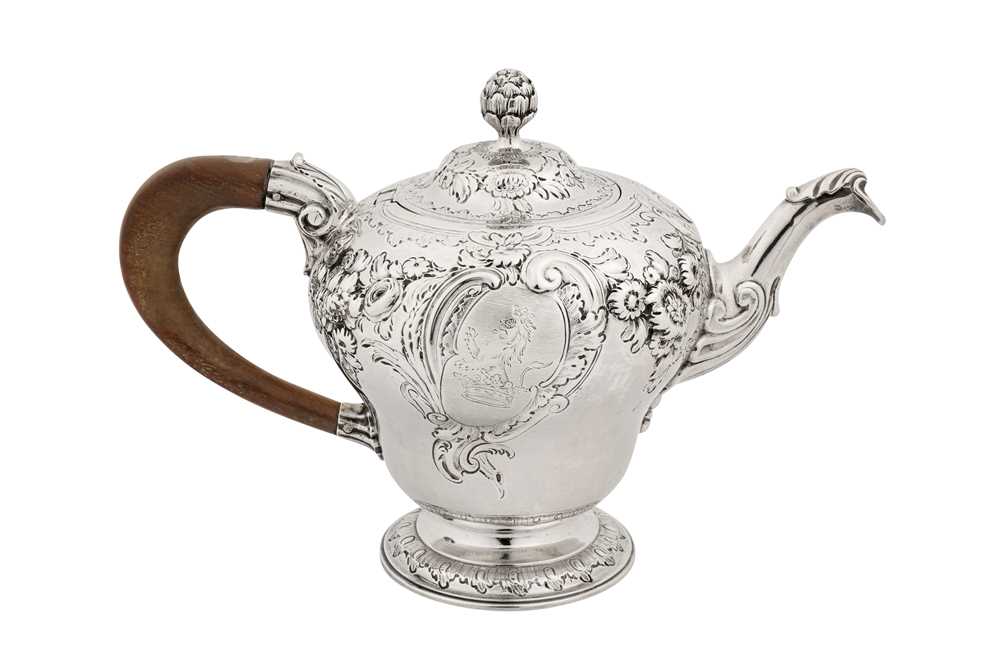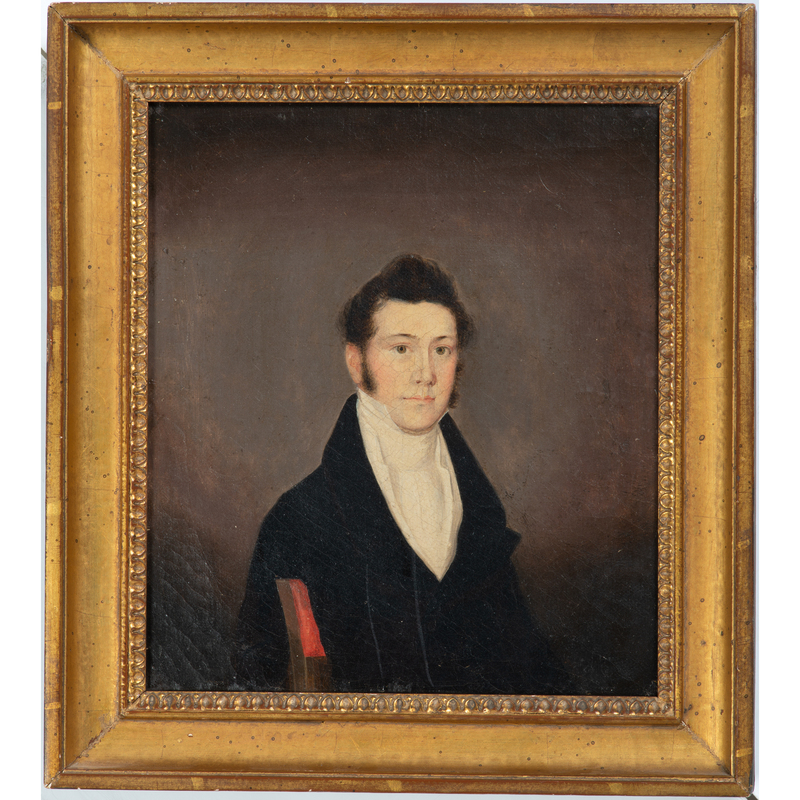Early Colonial American interest Richard Phillips (British, 1681-1741) Portrait of Governor Jonathan Belcher (1682-1757) oil on canvas, inscribed on reverse of canvas "---- Jonathan Belcher of Boston New England. Anno AEtatis Suae [in the year of his age] 34 1/2 R Phillips pinxit 1716", painted in 1716 when Jonathan Belcher was 34 years old, in original early 18th century portrait frame 35 1/4 x 28 1/4in. (89.5 x 71.75cm.) * Provenance: By descent from the Chamberlayne family of Stoneythorpe Hall Warwickshire, England. The family had lived there since the 1600s. Thermuthes Chamberlayne married the son of the Governor of Virginia in 1797. ** Notes: A significant Colonial portrait of one of the most interesting and influential figures in early American history. Jonathan Belcher became Governor of the Province of New Jersey from 1747 to 1757 and is regarded today as the founder of Princeton University. He was born on 8th January 1682 in Cambridge, Massachusetts, the son of Captain Andrew Belcher and Sarah Gilbert He descended from the Belcher family of Guilsborough, Northamptonshire. He graduated from Harvard College in 1699 and in 1704 embarked upon a grand tour of Europe, visiting Holland, Germany and England where he met Princess Sophia and the future George II. In 1706 he married his first wife, Mary Partridge, the daughter of a former lieutenant governor of New Hampshire. In 1715 Jonathan Belcher made another trip to England where he defended Massachusetts' charter privileges and helped Governor Samuel Shute in his bid to become Governor of Massachusetts and New Hampshire, which he accomplished in October 1716. It was during Jonathan Belcher's visit to England in 1715/16 that Richard Phillips (1681-1741) painted this portrait. Richard Phillips was born in London in 1681 and, as far as it is known, he lived there until the end of his life in 1741. He was a principally a portrait painter and developed a prestigious client list including politicians and landowners and there are portraits by him in the National Portrait Gallery and Bank of England. Some of his portraits were engraved. A mezzotint of Jonathan Belcher was published in 1734 after a copperplate engraving by the Dutch portrait engraver John Faber the Younger (1684-1756), who was active in London. This was derived from a portrait by Richard Phillips potentially the present picture. Copies of the mezzotint survive but not the engraving. Belcher ordered the plate to be destroyed and all impressions taken from it. The mezzotint depicts the sitter as Royal Governor of Massachusetts Bay and New Hampshire prior to becoming Governor of New Jersey. Although the coat and background are notably different the head and hand bear a very close resemblance to the portrait offered here. A full length portrait by Richard Phillips is recorded as having been presented to Princeton College by Jonathan Belcher at the time that he donated his extensive library. Sadly, this portrait was destroyed during the American Revolution. The portrait offered here is therefore a very significant discovery as it is the most authentic likeness of an historic figure from America's Colonial past.
Early Colonial American interest Richard Phillips (British, 1681-1741) Portrait of Governor Jonathan Belcher (1682-1757) oil on canvas, inscribed on reverse of canvas "---- Jonathan Belcher of Boston New England. Anno AEtatis Suae [in the year of his age] 34 1/2 R Phillips pinxit 1716", painted in 1716 when Jonathan Belcher was 34 years old, in original early 18th century portrait frame 35 1/4 x 28 1/4in. (89.5 x 71.75cm.) * Provenance: By descent from the Chamberlayne family of Stoneythorpe Hall Warwickshire, England. The family had lived there since the 1600s. Thermuthes Chamberlayne married the son of the Governor of Virginia in 1797. ** Notes: A significant Colonial portrait of one of the most interesting and influential figures in early American history. Jonathan Belcher became Governor of the Province of New Jersey from 1747 to 1757 and is regarded today as the founder of Princeton University. He was born on 8th January 1682 in Cambridge, Massachusetts, the son of Captain Andrew Belcher and Sarah Gilbert He descended from the Belcher family of Guilsborough, Northamptonshire. He graduated from Harvard College in 1699 and in 1704 embarked upon a grand tour of Europe, visiting Holland, Germany and England where he met Princess Sophia and the future George II. In 1706 he married his first wife, Mary Partridge, the daughter of a former lieutenant governor of New Hampshire. In 1715 Jonathan Belcher made another trip to England where he defended Massachusetts' charter privileges and helped Governor Samuel Shute in his bid to become Governor of Massachusetts and New Hampshire, which he accomplished in October 1716. It was during Jonathan Belcher's visit to England in 1715/16 that Richard Phillips (1681-1741) painted this portrait. Richard Phillips was born in London in 1681 and, as far as it is known, he lived there until the end of his life in 1741. He was a principally a portrait painter and developed a prestigious client list including politicians and landowners and there are portraits by him in the National Portrait Gallery and Bank of England. Some of his portraits were engraved. A mezzotint of Jonathan Belcher was published in 1734 after a copperplate engraving by the Dutch portrait engraver John Faber the Younger (1684-1756), who was active in London. This was derived from a portrait by Richard Phillips potentially the present picture. Copies of the mezzotint survive but not the engraving. Belcher ordered the plate to be destroyed and all impressions taken from it. The mezzotint depicts the sitter as Royal Governor of Massachusetts Bay and New Hampshire prior to becoming Governor of New Jersey. Although the coat and background are notably different the head and hand bear a very close resemblance to the portrait offered here. A full length portrait by Richard Phillips is recorded as having been presented to Princeton College by Jonathan Belcher at the time that he donated his extensive library. Sadly, this portrait was destroyed during the American Revolution. The portrait offered here is therefore a very significant discovery as it is the most authentic likeness of an historic figure from America's Colonial past.















Testen Sie LotSearch und seine Premium-Features 7 Tage - ohne Kosten!
Lassen Sie sich automatisch über neue Objekte in kommenden Auktionen benachrichtigen.
Suchauftrag anlegen